In just a couple of days, Kaldheim previews begin in earnest. The Norse-and-Germanic-inspired set will drop amidst a sharp rise in the appropriation of Heathen culture and religious symbols by far-right ethnonationalist groups, putting some members of the Magic community on guard after several years of emboldened white supremacy in the U.S. and Europe.
This issue—fantasy harmfully appropriating cultures or itself being harmfully appropriated by fascist groups—has a long and complex history, and a full treatment is likely big enough for several books, let alone my meager word limit. Nevertheless, Magic has had a mixed record when it comes to how they’ve dealt with the real-world cultures they borrow from to craft the vast multiverse of planes that its characters visit. The discourse over the past few months warrants attention, so I wanted to take a look at what’s going on with Norse Paganism, or Asatru, ahead of Kaldheim’s release, to find out what practitioners of Asatru have to say about the appropriation of Norse culture and religion.
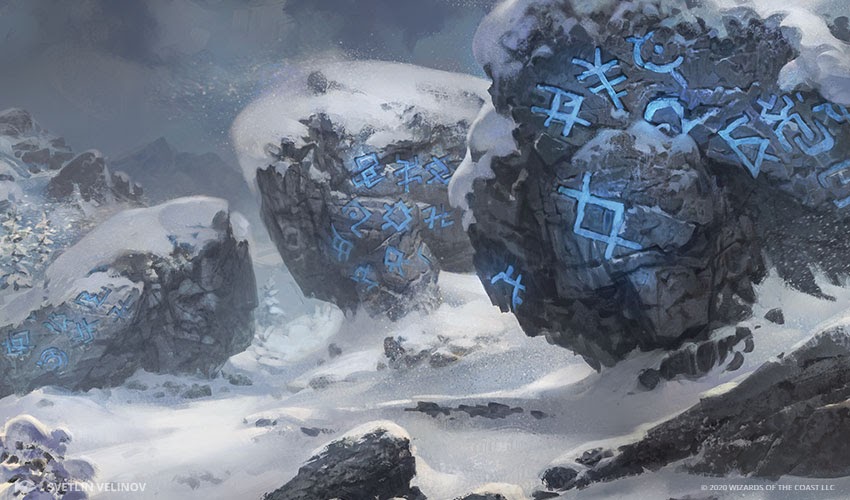
Art by Svetlin Velinov
Messiness in Midgard
Since its announcement in September, Kaldheim has been met with a mixture of emotions. Mostly, we see excitement, like this:
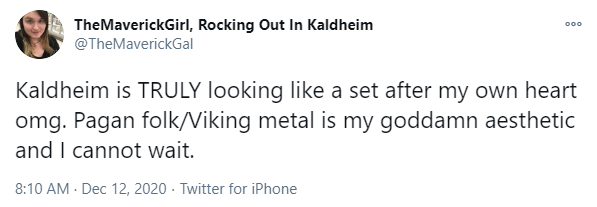
But there have also been expressions of concern:
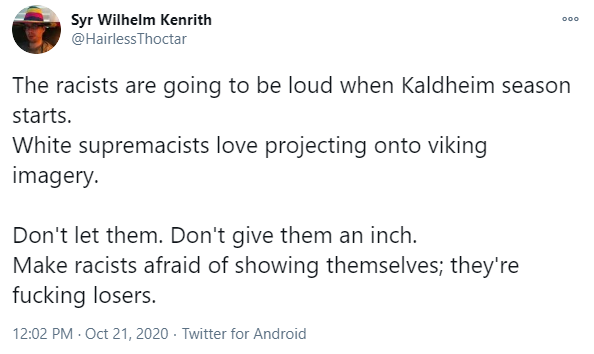
Concerns that this set might give white ethno-nationalists something to latch onto or even attract them are not wholly unfounded. Already, with September’s announcement and the eyebrow (and axe?)-raising “Week of Metal,” in December, we’ve seen at least a few posts on social media referencing a preference for cultural or racial “purity” in the set:
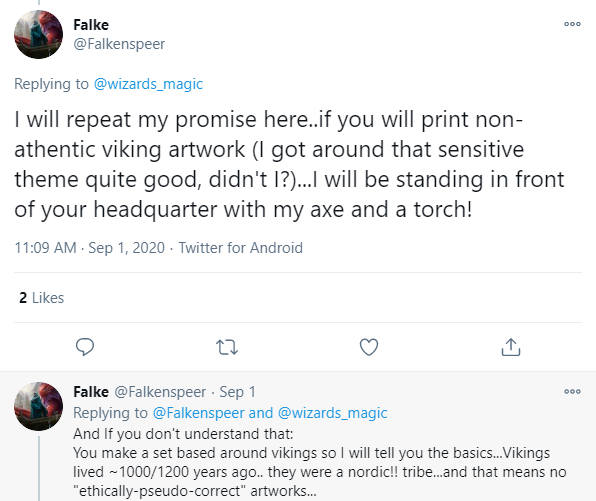
Tweets like the one above are a minority, yet there’s reason to suspect this tweet is an example of a larger and more troubling trend. Around the same time as the “Week of Metal,” in December, the Asatru Folk Assembly—identified by the Southern Poverty Law Center as a white supremacist organization—made national news when it was granted a permit to assemble in a previously abandoned church building it purchased in the small town of Murdock, MN.
So what’s going on with contemporary forms of Paganism and Heathenry? Anthropologist Amy Hale argues in her essay “The Pagan and Occult Fascist Connection and How to Fix It” that despite some strong association with left-leaning or countercultural ideas (e.g., nature spirituality, rejection of Christian hegemony, etc.), the degree to which Paganism and the occult have been embedded also in conservative and radical right ideologies “far beyond the well-known tropes of esoteric Nazism” has sometimes been overlooked. There are some structural compatibilities, she continues, “between some aspects of Pagan and occult culture and the ideals of some sectors of the radical right,” namely, the embrace of a marginalized identity, invocation of interest in the survival of ancient folk traditions, which often include a kind of environmentalism. On their faces, these values might be attractive to a wide range of people—perhaps associated with progressives or “hippies” as presented to us by the trope Hale challenges—but we’d do well to remember also that these values often accompany “Romantic aesthetics and sensibilities, which create the space for what are essentially conservative discourses.”
That is, like traditional forms of Christianity (Catholicism, Orthodoxy, etc.), Paganisms are interested in the preservation or restoration of ancient values and practices. The seductive and pernicious link between traditional religions like Paganisms and a radical right worldview, Hale continues, is “the idea of returning to or being in harmony with the natural state of things” where the definition of “natural” hides a prescription for a kind of ecofascism or nativism. Of course, as I’ve written previously, a debate over “the natural state of things” was at the very heart of the conflict of Zendikar Rising; Donny Caltrider and I touched on this in our essay “The Green Man Seen Through Magic” as well.
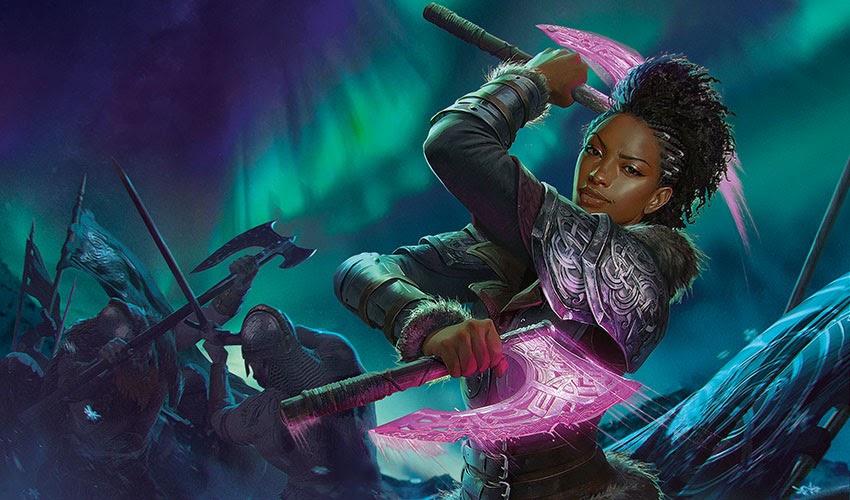
Kaldheim Key Art by Anna Podedworna
A Shieldwall against Hate
These Eco-fascists and “Neo-völkisch” right-wing movements are highly visible, but they aren’t the whole of practicing Heathenry, nor even the majority. While writing this essay, I reached out to prominent groups via Twitter and Facebook—Awaken the North, The Asatru Community, Grimnir’s Crossroads Kindred, and Wolves of the North—to help me get a handle on how insiders see things like this. The groups I reached out to, and many I simply looked up or observed, take a strong stand against “Neo-völkisch” groups that use Norse Paganism as a vehicle for the legitimization of hatred and bigotry. Edward Knightrün of Grimnir’s Crossroad Kindred likened these Neo-völkish groups to Christians who take “Christ’s teachings and twist them around to justify their own worldviews” and elaborated that, “In order to gain acceptance, they mask their beliefs as religious.”
As a way to combat what they saw as a negative appropriation and abuse of sacred traditions, 180 organizations from over 20 different nations came together to create and sign Declaration 127, denouncing a large group known as the Asatru Folk Assembly, or AFA, and their racist iteration of Asatru. Based on words thought to be from Odin himself, from scriptures called the Hávamál, the declaration states: “Wherever you know of harm, regard that harm as your own; Give your enemies no frið.” Frið translates roughly to “peace,” and the sentiment here resonates with the denunciation of negative peace in Martin Luther King Jr’s, “Letter from a Birmingham Jail,” the need to take direct action for the sake of justice to truly establish real peace, not simply the absence of conflict.
Knightrün, along with members of The Asatru Community, and others, took this farther and created “Shieldwall”—a pledge that expanded the Declaration to address all racism and bigotry rather than simply that of one group. At time of writing, this pledge has the signatures of more than 100 organizations and over 2300 individuals. Topher Henry, president of The Asatru Community, added that in addition to these initiatives, he and members of groups like TAC and Heathens Against Hate have been engaged in protests in their local cities, as well as petitions to stop the spread of groups like the AFA. “Ours is a religion that racists try to take as their own,” Henry told me, “and we fight against them however we can.”
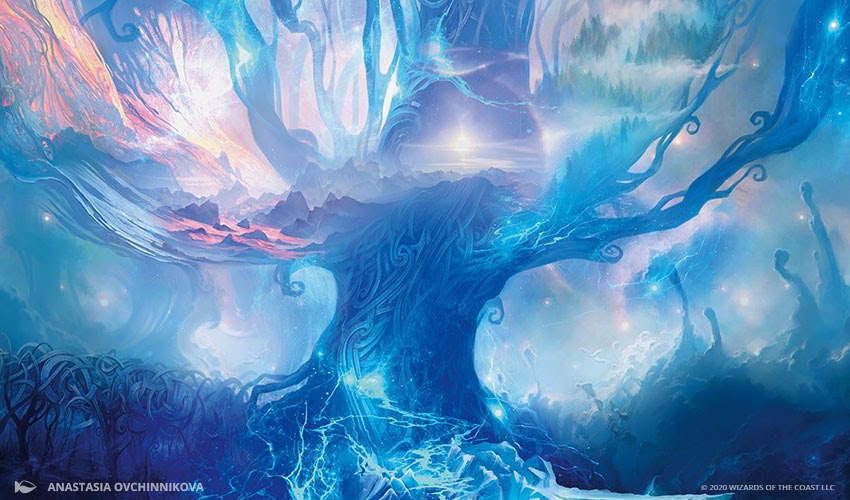
Art by Anastasia Ovchinnikova
But Is Magic “Worthy?”
How do Heathens look at pop-culture appropriation of the sort that Magic is doing with Kaldheim? On one hand, Chagi says, in part due to Tolkein’s influence, modern fantasy has its deepest roots in Norse and Germanic mythoi, and he and others view it as a generally positive thing that contemporary fantasy borrows from this tradition. As Dr. Karl E.H. Seigfriend wrote in 2013, the use—by Marvel, Wizards of the Coast, etc— of iconic deities like Thor “to tell very modern stories of life in America and even to work out issues related to [for example] the horrors of World War II” in ways analogous to how some members of Jewish and Christian denominations tell their stories is a sign that these stories are still alive and making a positive impact in peoples’ lives. As regards Magic’s Kaldheim, Knightrün says that it is doing this very thing: “Art is supposed to inspire people, make them question things, and start conversations,” and noted, “the fact that you contacted me in the first place means they’re doing their job.” Sal Donancricchia of Wolves of the North agrees, citing that he came to Heathenry and his eventual ordination in Asatru in part because of his initial exposure to metal in the 1980s.
There are, of course, downsides. Seth Chagi says that along with the positive attention that pop-culture can bring to Norse Paganism and Asatru, there’s a lot of ignorance. “More respect would be appreciated,” he told me. Because these are sacred traditions, “it’s cultural appropriation, in a way.” Donancricchia says that while it isn’t terribly upsetting, much of Hollywood’s representation of vikings and ancient Norse spirituality does distort the truth, and even well-meaning people often have misguided notions of what Asatru is about. “They assume it’s a comic book religion,” he told me, “or viking LARP,” and don’t realize the spirituality, learning, or even the study of ancient languages that goes into their practice of the faith. Knightrün expressed a similar sentiment, lamenting that he wishes people would “do a little more research before they show up practicing Heathenry in a weird parody of Vikings and Marvel comics,” although he adds that “if that’s what it takes to set them on the right path, […] who am I to judge?”
One place all are wary, however, is in the representation of Heathenry in any way that makes it seem like racism or any other form of bigotry is acceptable or part of the fabric of Asatru. As Goði Casey “Beast” Clarke from Awaken the North told me, “Our goal is to create a safe space for all, where we may learn, grow, and support each other on our spiritual walks through Heathenry.” In this way, the inclusion of non-white and gender non-binary characters in the Nordic setting of Kaldheim might be something akin to a shieldwall against its being co-opted by less than savory groups.
Referring to the inclusion of non-white and gender-nonbinary characters in the set, Topher Henry exclaimed “This is all excellent!” He continued by emphasizing that while sometimes it occurred by force, contrary to the narratives of Neo-völkisch groups, during the Viking Age, the Norse welcomed many different peoples of diverse heritages and religions into their communities. However, this cultural exchange wasn’t always violent, and wasn’t one-directional: the Norse traveled and traded widely, Henry told me, adding that when it came to Magic’s use of the viking age for inspiration, “it makes sense to show that diversity [alongside] the Norse penchant for intricately carved ships, longhalls, ornate jewelry and body adornments.” From the 2017 article in The Atlantic, practitioners told Sigal Samuel that the original mythology, with its mixed-race and sometimes gender-fluid deities, presents a “a wonderful blueprint” for multiculturalism and diversity.
Members of right-wing movements might take issue with seeing non-Nordic characters in a viking-inspired game; but as I said just above, a number of Heathens I spoke to pointed out that there’s historical and theological warrant for these choices. “Odin is the Allfather, not the Somefather,” a saying goes. Indeed, Kaldheim hasn’t seemed to upset any of the Heathens I’ve spoken to. By and large, they see the set as a cultural phenomenon that might even lead to more opportunities to talk about their traditions.
My ultimate takeaway from observing the community discourse, from talking to a number of practicing Asatruar, and from researching this issue in news journals and academic literature, is perhaps obvious, but it was comforting to hear others saying it as well: If we’re concerned about appropriation and fascism in our communities, be they religions or fandoms, we have to take an inexorable stand against it—whether the culprit is a company producing content that we find harmful, or bad actors co-opting things we love with the aim of legitimizing their prejudices.
Next month, I’ll be taking a comparative mythological look at the Kaldheim story. Until then.
Further Information:
If you are interested in learning more about Asatru and the practice of Norse Heathenry, you may visit any of the following websites, and/or reach out to their administrators, who were all very kind and open to talking about their traditions. My special thanks to the members of the following groups quoted in this article:
Organizations:
Awaken the North
The Asatru Community
The Troth
Local Kindreds:
Wolves of the North Kindred (Chicago / Milwaukee)
Grimnir’s Crossroad Kindred (Indiana)
If you’re like me, the short playlist that Wizards released just wasn’t enough, nor did it—in my opinion—really capture some of what I love about Norse mythology and aesthetics. I’ve put together this list for your listening pleasure—Skål!
Jacob Torbeck is a researcher and instructor of theology and ethics. He hails from Chicago, IL, and loves playing Commander and pre-modern cubes.
Cover art: “Halvar, God of Battle,” by Milivoj Ćeran.

